Shading projections for new dwellings
Eave, balcony, porch and verandah projections are measured to the outside edge of the feature including any fixed attachment such as a gutter. For example, if your roofing truss overhangs by 450mm and you have a standard 25mm fascia and 125mm gutter, then select 600mm projection. Measure projection to the face of the wall in which the window is located.
Note: Shading with an external permanent projection must extend horizontally on both sides of the window or glazed door for a distance not less than the projection (P).
A shading projection that is less than 500mm above the head (e.g. eave) will typically provide reasonable shading whereas a projection that is higher (e.g. skillion roof) will allow more sun to hit the window and will be less effective.
The BASIX DIY method will account for half of the projection specified if the leading edge of each eave, pergola, verandah, balcony or awning is between 500mm and 1500mm above the head of the window or glazed door. DIY method will not give credit for projections greater than 1500mm above the window head.
Tip: The Simulation method allows you to enter a greater range of shading projections than the DIY method.
1.Measure the projection (P) of an eave or solid overhang from the window to the leading edge including the gutter.
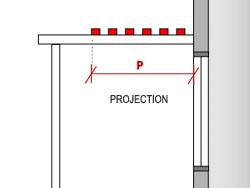
2. Measure the height above window head (G) of an eave from the leading edge to the top of the window.
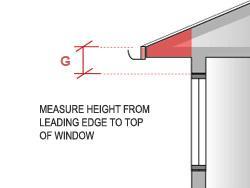
3. Measure the projection (P) of a shading device from the window to the leading edge.
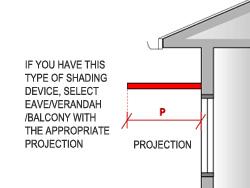
4.For a verandah, measure the height (G) from the sill of the window to the leading edge of the verandah.
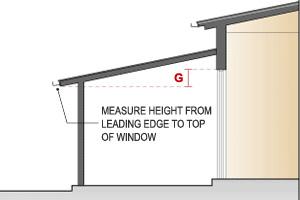
Shading projections for alterations and additions
Eave, balcony, porch and verandah projections are measured to the outside edge of the feature including any fixed attachment such as a gutter. For example, if your roofing truss overhangs by 450mm and you have a standard 25mm fascia and 125mm gutter, then select 600mm projection. Measure projection to the face of the wall in which the window is located.
Note: Shading with an external permanent projection must extend horizontally on both sides of the window or glazed door for a distance not less than the projection (P).
A shading projection that is less than 500mm above the window head (e.g. eave) will typically provide reasonable shading whereas a projection that is higher (e.g. skillion roof) will allow more sun to hit the window and will be less effective. For Alterations and Additions, projections must be no more than 500mm above the window head and no more than 2400mm above the sill.
If a shading projection does not meet the above criteria, you may be able to use the projection/height above sill ratio. To calculate the ratio, measure the projection (P) of an eave or solid overhang from the window to the leading edge including the gutter, and measure the height (H) from the sill of the window to the leading edge. Be sure to use the same units. The projection/height above sill ratio equals the projection (P) divided by the height above the sill (H).
Tip: The projection/height above sill ratio may be more suitable for small windows or for windows where H is small.
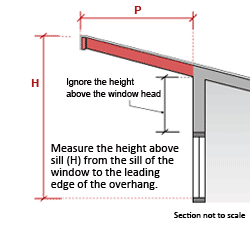
Measure the projection (P) of an eave or solid overhand from the window to the leading edge including the gutter
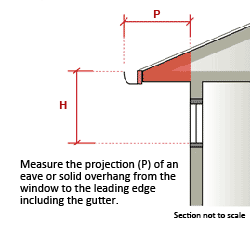
Pergolas
Fixed shading with battens
Pergolas with battens must have battens parallel to the window or glazed door to qualify as a shading device. Pergolas with only the framing or members perpendicular to the window or glazed door do not provide sufficient shading to be considered. Battens that are perpendicular to the window or glazed door can only be counted if they are also providing shading to an adjacent window or glazed door such as in a courtyard.
The batten spacing (that is, the distance between battens) must not exceed the batten height.

For a pergola with fixed battens, measure the projection (P) from the window to the leading edge, that is, the last batten in the series.
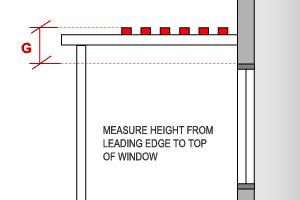
For a pergola with fixed battens, measure the height (G) from the head of the window to the leading edge, that is to the top of the batten series.
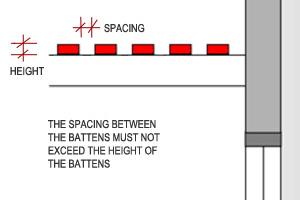
For a pergola with fixed battens, the spacing between battens must not exceed the thickness of the battens.
Fixed shading with sheeting
Pergolas with polycarbonate or fibreglass sheeting or other similar material must have a shading coefficient of less than 0.35. The lower the shading coefficient the better the shading. Manufacturers can provide the shading coefficient of their product range. Generally clear sheeting will not have a shading coefficient less than 0.35 – a tinted sheet will need to be used for the pergola to qualify as a shading device.
If you want to have a pergola with clear sheeting or tinted sheet with a shading coefficient of greater than 0.35 you must nominate ‘no shading’ for that window. However, you can still build the pergola.
Adjustable Shading
Select pergola with adjustable shading if you have adjustable blades or removable shade cloth. Adjustable blades must be capable of blocking the sun in plan view, i.e. when viewed from above – most systems are designed this way.
Removable shade cloth must have a shade ratio of at least 80% to be considered. Most manufacturers provide their shading products with the shade ratio specified.
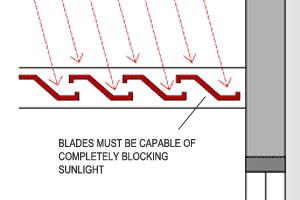
For a pergola with adjustable blades, the blades must be capable of completely blocking sunlight when it is directly overhead.Awnings
Awnings can provide very effective shading as they typically cover below the window head. Select fixed or adjustable awnings depending on the whether the awning can be retracted or removed to permit winter sun.
Tip: For awnings that do not project from the wall, select "external louvre / vertical blind" instead.
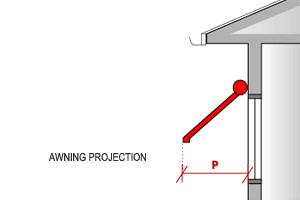
For fixed or adjustable awnings, measure the projection (P) from the window to the leading edge of the awning.
External louvres and blinds
Select "external louvre / vertical blind" for devices that pull down or across to completely cover the window. This includes motorised blinds, fixed blades or sliding screens with fixed or adjustable blades.
Select fixed or adjustable louvres or blinds depending on whether the louvre or blind can be retracted to permit winter sun.
Note: Devices that do not completely cover the window cannot be nominated using DIY.
| Shading Projections | |
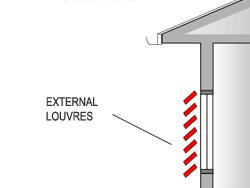
|
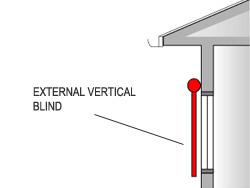
|
| Diagram showing louvres | Diagram showing external vertical blind |